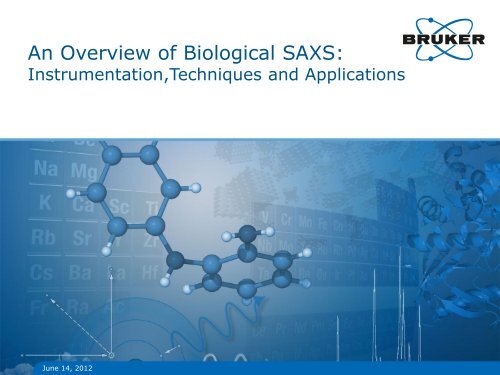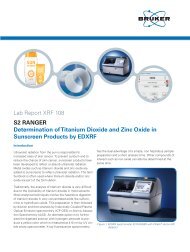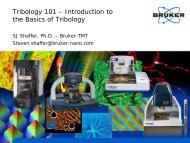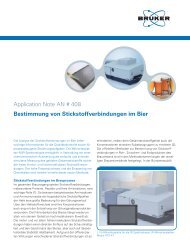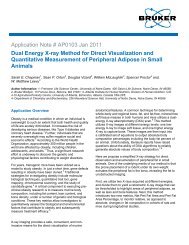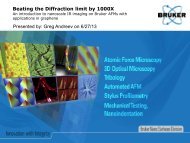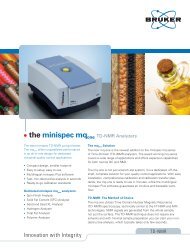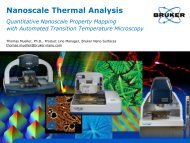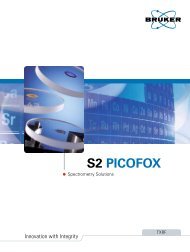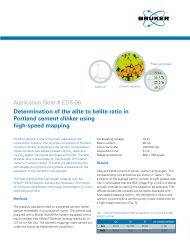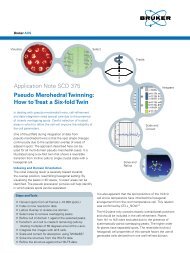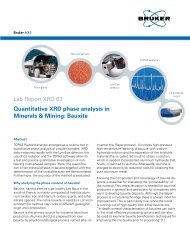Bruker AXS Overview of Biological SAXS Webinar 20120614
Bruker AXS Overview of Biological SAXS Webinar 20120614
Bruker AXS Overview of Biological SAXS Webinar 20120614
Create successful ePaper yourself
Turn your PDF publications into a flip-book with our unique Google optimized e-Paper software.
An <strong>Overview</strong> <strong>of</strong> <strong>Biological</strong> S<strong>AXS</strong>:<br />
Instrumentation,Techniques and Applications<br />
June 14, 2012
Welcome<br />
Peter Laggner<br />
Director<br />
Nanostructure Solutions<br />
<strong>Bruker</strong> <strong>AXS</strong> - Austria<br />
peter.laggner@bruker.at<br />
+43 664 3002738<br />
Brian Jones<br />
Sr. Applications Scientist, XRD<br />
<strong>Bruker</strong> <strong>AXS</strong> Inc. – Wisconsin, USA<br />
brian.jones@bruker-axs.com<br />
+1.608.276.3088<br />
2
Pioneers <strong>of</strong> (Bio-)S<strong>AXS</strong><br />
Otto Kratky developed the<br />
first commercially successful<br />
S<strong>AXS</strong> camera<br />
Andre Guinier – Concept <strong>of</strong><br />
particle scattering – radius <strong>of</strong><br />
gyration<br />
Andre Guinier<br />
Otto Kratky<br />
3
Contents<br />
• What is S<strong>AXS</strong><br />
• What can S<strong>AXS</strong> do for biology<br />
• Biopolymer structure – proteins and beyond<br />
• Membrane structure and dynamics<br />
• The ‚Hybrid Analysis Approach‘<br />
• S<strong>AXS</strong> and Crystallography<br />
• S<strong>AXS</strong> and Calorimetry<br />
• S<strong>AXS</strong> and NMR<br />
• S<strong>AXS</strong> and EM<br />
• Lab and Synchrotron S<strong>AXS</strong><br />
• What is needed in instrumentation<br />
• Optics: flux and resolution, background optimization<br />
• Sample environment<br />
• S<strong>of</strong>tware<br />
• Summary <strong>of</strong> the <strong>Bruker</strong> S<strong>AXS</strong> product range<br />
4
S<strong>AXS</strong> - X-Ray Scattering in Transmission<br />
X-Ray Beam<br />
> 6°<br />
XRD/W<strong>AXS</strong><br />
Internal structure,<br />
Crystal parameters<br />
0.02 - 6°<br />
S<strong>AXS</strong><br />
Particle size/shape<br />
Nanosized pores,<br />
Defects<br />
5
The Length Scales<br />
x 10 6<br />
nm µm mm<br />
SW<strong>AXS</strong><br />
Liposomal<br />
Carrier<br />
Porous mineral<br />
The<br />
Product<br />
This is where all the<br />
chemistry happens<br />
This is our reality<br />
6
Typical Time Scales<br />
-6 -4 -2 0 2<br />
log t (s)<br />
Synchrotron beamlines<br />
Lab instruments<br />
7
The Reciprocity: Size – Scattering Angle<br />
Small<br />
particles<br />
Wide S<strong>AXS</strong> range<br />
Large<br />
particles<br />
Narrow S<strong>AXS</strong> range<br />
8
angle (degrees)<br />
Why is S<strong>AXS</strong> Special<br />
• The angular resolution needs to be much better for S<strong>AXS</strong> than for XRD –<br />
• only ~ 6° ROI for two decades in real space<br />
50<br />
40<br />
W<strong>AXS</strong><br />
30<br />
Molecular Lattice<br />
Unit cell dimensions<br />
symmetry<br />
20<br />
10<br />
0<br />
Nano-Envelope<br />
Size / Shape<br />
S<strong>AXS</strong><br />
10 100 1000<br />
distance (A)<br />
9
Advantages <strong>of</strong> Simultaneous<br />
S<strong>AXS</strong> and W<strong>AXS</strong><br />
S<strong>AXS</strong><br />
W<strong>AXS</strong><br />
crystalline<br />
Scattering<br />
curve<br />
amorphous<br />
150 nm 1<br />
10 Angström 3<br />
Nanoscale<br />
domains/particles/<br />
pores<br />
Atomic / molecular scale<br />
10
Where Can S<strong>AXS</strong> Help in Biology<br />
• Drug Discovery – Proteomics – Structural Biology<br />
• Drug Development – Formulation – Process Control<br />
• Biomaterials - Hair, Skin, Bone, Tissue Engineering<br />
• Biochem / Biophys Basic Research<br />
11
Biochem/Biophys Basic Research<br />
The most important applications <strong>of</strong> S<strong>AXS</strong> in basic research relate to:<br />
• Macro- / supramolecular interactions in solution with small<br />
molecules, salts , (H<strong>of</strong>meister series …)<br />
• Supramolecular complex formation in solution (protein-lipid, proteinnucleic<br />
acid,…)<br />
• Self-assembly <strong>of</strong> amphiphilic compounds (Micelle formation ,<br />
coagulation…)<br />
Laboratory S<strong>AXS</strong>/SW<strong>AXS</strong>/GIS<strong>AXS</strong> become<br />
complementary standards to spectroscopic and<br />
thermodynamic tools in biophysics/biochemistry.<br />
Powerful instruments provide the necessary speed<br />
<strong>of</strong> measurement.<br />
12
Proteomics – Structural Biology<br />
Q: Drug binding effect on enzyme structure in solution<br />
‣ S<strong>AXS</strong> in dilute solution – radius <strong>of</strong> gyration (R G ) , molecular weight , max.<br />
dimension<br />
Q: Search for optimum crystallization conditions<br />
‣ S<strong>AXS</strong> in different salt or polymer solutions – size (R G ) monitors<br />
attractive/repulsive interactions<br />
Q: Differences between X-ray crystal structure and solution structure<br />
‣ S<strong>AXS</strong> curve fitting with crystal date (e.g. from PDB data bank)<br />
Q: Oligomerization / multi-protein assembly in solution<br />
‣ S<strong>AXS</strong> under different protein concentrations – how to bring more protein into<br />
1 ml <br />
13
S<strong>AXS</strong> in Structural Proteomics and<br />
Drug Discovery<br />
Genomics<br />
Protein<br />
Synthesis<br />
Candidate<br />
Selection<br />
Protein<br />
Structure<br />
Rational<br />
drug design<br />
Protein sizing to determine:<br />
• State <strong>of</strong> aggregation in solution<br />
(monodisperse/polydisperse)<br />
• Suitability for crystallization<br />
• Effects <strong>of</strong> salts, additives, ligands<br />
14
Biomaterials: Hair, Skin, Bone, Wood…<br />
NANOGRAPHY :<br />
This is the domain <strong>of</strong> NANOSTAR<br />
Small- and wide-angle patterns <strong>of</strong> oriented<br />
samples – 2D detection / sample scanning<br />
15
BioS<strong>AXS</strong> Sample - Practice<br />
Samples typically consist <strong>of</strong> biological macromolecules and<br />
their complexes (proteins, DNA and RNA) in solution<br />
• Homogeneous<br />
• Monodisperse<br />
• Concentration: >1 mg/ml<br />
• Sample amount: 10-15 ml<br />
• Perfectly matched buffer solution provided for solvent<br />
blank measurement<br />
16
log I<br />
S<strong>AXS</strong> Information on Protein Structure<br />
shape<br />
experimental data<br />
theoretical pr<strong>of</strong>ile from atomic model<br />
<br />
folding<br />
atomic structure<br />
50 Å<br />
0,0 0,1 0,2 0,3 0,4<br />
Graphics courtesy <strong>of</strong> Michal Hammel S<strong>AXS</strong> Consulting www.saxs.org<br />
q[Å -1 ]<br />
13 Å<br />
17
Particle Size – Guinier Law<br />
Guinier law:<br />
I(q) = I(0).e −R2 q 2 /3<br />
ln I q = lnI(0) − R 2 q 2 /3<br />
Valid up to q.R ≤ 1,2<br />
• Guinier plot:<br />
• Rg, radius <strong>of</strong> gyration.<br />
• I(0), Molecular weight<br />
Slope = - ln(10) . R 2 /3<br />
Graphics courtesy <strong>of</strong> Michal Hammel S<strong>AXS</strong> Consulting www.saxs.org<br />
18
Protein Folding - Kratky Plot<br />
The appearance <strong>of</strong> the<br />
S<strong>AXS</strong> curve in the<br />
Kratky plot allows to<br />
infer chain folding<br />
characteristics -<br />
Graphics courtesy <strong>of</strong> Michal Hammel S<strong>AXS</strong> Consulting www.saxs.org<br />
19
Fourier Transformation – The P(r) Function<br />
P(<br />
r)<br />
<br />
1<br />
2<br />
<br />
2<br />
<br />
0<br />
I(<br />
q).<br />
q<br />
2<br />
sin( qr)<br />
qr<br />
dq<br />
Limit:<br />
q min .D max ≤ π<br />
P r<br />
= T( I(q))<br />
The Pair Distance Distribution Function P(r) is the Fourier Transform <strong>of</strong> the S<strong>AXS</strong><br />
curve – it is a real-space function and hence intuitively better suited for modelling<br />
Graphics courtesy <strong>of</strong> Michal Hammel S<strong>AXS</strong> Consulting www.saxs.org<br />
20
Pair Distance Distribution Function P(r)<br />
Maximum particle dimension, general shape<br />
Graphics courtesy <strong>of</strong> Michal Hammel S<strong>AXS</strong> Consulting www.saxs.org<br />
21
S<strong>AXS</strong> Size Range<br />
Limit:<br />
q min .D max ≤ π<br />
Putnam and Hammel et<br />
al. 2007 Q R Biophysics<br />
40:191-285<br />
Graphics courtesy <strong>of</strong> Michal Hammel S<strong>AXS</strong> Consulting www.saxs.org<br />
22
Solution Structure Modeling<br />
Graphics courtesy <strong>of</strong> Michal Hammel S<strong>AXS</strong> Consulting www.saxs.org<br />
23
Proteomic Scale, Shape and Assembly<br />
Hura, Menon, Hammel et al.<br />
(2009) Nature Methods 6,<br />
606 - 61<br />
Graphics courtesy <strong>of</strong> Michal Hammel S<strong>AXS</strong> Consulting www.saxs.org<br />
24
In 1971: 10 min/point<br />
25
Today:<br />
Protein Size and Shape Within Minutes by Lab-S<strong>AXS</strong><br />
3 min 6 min 9 min<br />
Pair Distance<br />
Distribution<br />
12 min 15 min 18 min<br />
(<strong>Bruker</strong> MICROPix)<br />
Stable results after < 12 min exposure<br />
Size (Radius <strong>of</strong> Gyration) to < +/- 3 % within 3 min<br />
Sample volume < 10 µl; concentration 0.1% -<br />
26
Speed <strong>of</strong> S<strong>AXS</strong><br />
Dilute protein solution S<strong>AXS</strong> in human times – one c<strong>of</strong>fee break<br />
0.4%, Exposure 30 min<br />
ALD BSA<br />
THI Lyso<br />
q min = 0.016 Å -<br />
1<br />
d = 400 Å<br />
27
Speed <strong>of</strong> Analysis – BSA model in 15 min<br />
Experimental vs<br />
fitted I(q)<br />
Crystal Structure<br />
S<strong>AXS</strong><br />
p(R)<br />
DIMER<br />
28
Conclusions<br />
• Protein S<strong>AXS</strong> does not require synchrotron radiation<br />
• Valuable S<strong>AXS</strong> data can be obtained in 30 min or less<br />
• Radii <strong>of</strong> Gyration can be determined in less than 5 min<br />
• Data <strong>of</strong> sufficient quality for informative molecular modeling<br />
can be obtained in the home laboratory<br />
29
Lipidic Formulations<br />
Membrane Biophysics<br />
Q: Polymorphic structure and transitions <strong>of</strong> liposomal formulations<br />
‣ Simultaneous small-and wide-angle scattering (SW<strong>AXS</strong>) in<br />
T-/c-/p- scanning mode<br />
Q: Interactions between lipid model systems and drugs<br />
‣ Dose-dependent SW<strong>AXS</strong> scanning<br />
Q: Simultaneous calorimetric and structural measurement<br />
‣ Integrated SW<strong>AXS</strong> – scanning microcalorimetry<br />
Q: Solid-supported thin lipid films ORIENTED! 2D-pattern<br />
‣ Grazing-incidence S<strong>AXS</strong> (GIS<strong>AXS</strong>)<br />
30
Liposomes and Lipoplexes<br />
a Rich Field for S<strong>AXS</strong>/W<strong>AXS</strong><br />
Starting from the<br />
components:<br />
Lipid self-assembly<br />
31
Thermal Phase Transitions<br />
SW<strong>AXS</strong> T-Scans<br />
Dipalmitoyl-PC (DPPC)<br />
0.5°/min, 1 frame/min<br />
Phases: L ‘ , P ‘ , L <br />
32<br />
S<strong>AXS</strong>: lamellar stacking structure<br />
W<strong>AXS</strong>: hydrocarbon<br />
chain packing<br />
5.0<br />
48.0<br />
50.0<br />
53.0<br />
54.0<br />
61.3 56.0<br />
56.0<br />
53.0<br />
5.0<br />
0.00 0.01 0.02 0.03 0.04 0.05 0.06<br />
s [1/Å]
Drug Liposome Interaction<br />
DSC-trace<br />
S<strong>AXS</strong><br />
33
Searching Targets for Anti-Viral Therapy<br />
Q: Which parts <strong>of</strong> the protein are responsible for fusion<br />
How can viral fusion with the cell membrane be suppressed<br />
Viral Fusion Protein: Membrane-<br />
Peptide Screening<br />
Viral entry:<br />
Membrane<br />
Fusion<br />
Viral Fusion<br />
Protein<br />
P. Laggner, Ana J. Perez Berna and Jose Villalain, 2007<br />
34
0.1 0.2 0.3 0.4<br />
0.1 0.2 0.3 0.4<br />
0.1 0.2 0.3 0.4<br />
0.1 0.2 0.3 0.4<br />
0.1 0.2 0.3 0.4<br />
0.1 0.2 0.3 0.4<br />
0.1 0.2 0.3 0.4<br />
0.1 0.2 0.3 0.4<br />
0.1 0.2 0.3 0.4<br />
0.1 0.2 0.3 0.4<br />
0.1 0.2 0.3 0.4<br />
0.1 0.2 0.3 0.4<br />
0.1 0.2 0.3 0.4<br />
0.1 0.2 0.3 0.4<br />
0.1 0.2 0.3 0.4<br />
10 20 30 40 50 60 70 10 20 30 40 50 60 70 10 20 30 40 50 60 70 10 20 30 40 50 60 70 10 20 30 40 50 60 70<br />
0.1 0.2 0.3 0.4 0.5<br />
0.1 0.2 0.3 0.4 0.5<br />
0.1 0.2 0.3 0.4 0.5<br />
0.1 0.2 0.3 0.4 0.5<br />
0.1 0.2 0.3 0.4 0.5<br />
0.1 0.2 0.3 0.4 0.5<br />
0.1 0.2 0.3 0.4 0.5<br />
0.1 0.2 0.3 0.4 0.5<br />
0.1 0.2 0.3 0.4 0.5<br />
0.1 0.2 0.3 0.4 0.5<br />
0.1 0.2 0.3 0.4 0.5<br />
0.1 0.2 0.3 0.4 0.5<br />
0.1 0.2 0.3 0.4 0.5<br />
0.1 0.2 0.3 0.4 0.5<br />
0.1 0.2 0.3 0.4 0.5<br />
10 20 30 40 50 60 70 10 20 30 40 50 60 70 10 20 30 40 50 60 70 10 20 30 40 50 60 70 10 20 30 40 50 60 70<br />
Host Membrane<br />
Viral Membrane<br />
197-214 260-277 274-298<br />
309-326<br />
351-368<br />
400-417 435-452 547-564 603-620 708-725<br />
25°<br />
25°<br />
q-axis (nm -1 )<br />
q-axis (nm -1 )<br />
q-axis (nm -1 )<br />
q-axis (nm -1 )<br />
q-axis (nm -1 )<br />
q-axis (nm -1 )<br />
q-axis (nm -1 )<br />
q-axis (nm -1 )<br />
q-axis (nm -1 )<br />
q-axis (nm -1 )<br />
45°<br />
45°<br />
q-axis (nm -1 )<br />
q-axis (nm -1 )<br />
q-axis (nm -1 )<br />
q-axis (nm -1 )<br />
q-axis (nm -1 )<br />
q-axis (nm -1 )<br />
q-axis (nm -1 )<br />
q-axis (nm -1 )<br />
q-axis (nm -1 )<br />
q-axis (nm -1 )<br />
70°<br />
70°<br />
q-axis (nm -1 )<br />
q-axis (nm -1 )<br />
q-axis (nm -1 )<br />
q-axis (nm -1 )<br />
q-axis (nm -1 )<br />
q-axis (nm -1 )<br />
q-axis (nm -1 )<br />
E2<br />
E11<br />
FP<br />
q-axis (nm -1 )<br />
q-axis (nm -1 )<br />
PreTM<br />
E13 E19 E24<br />
q-axis (nm -1 )<br />
F5<br />
F10<br />
Fusion Helper<br />
F27 F35 F49<br />
Temperature (ºC)<br />
Temperature (ºC)<br />
Temperature (ºC)<br />
Temperature (ºC)<br />
Temperature (ºC)
Searching Targets for Anti-Viral Therapy<br />
S<strong>AXS</strong> and DSC are suitable techniques for finding regions<br />
that promote non-lamellar phases likely to be involved in<br />
fusion.<br />
Fusion Peptide<br />
PreTM<br />
The region 603-620, fusion helper, 274-298, fusion peptide,<br />
and 309-326, PreTransmembrane domain are entry targets<br />
against HCV (hepatitis C virus).<br />
36
‚Hybrid Analysis‘<br />
Getting the Bigger Picture<br />
‚Hybrid Analysis‘ strategy combines methods and<br />
techniques <strong>of</strong><br />
• Diffraction<br />
• Spectroscopy<br />
• Imaging<br />
• Thermodynamics<br />
to get the complete picture <strong>of</strong> the complex<br />
structures, interactions and dynamics <strong>of</strong> biological<br />
systems at the submicroscopic scale<br />
37
‚Hybrid Analysis‘<br />
Combining Methods<br />
Diffraction<br />
SC-XRD<br />
atomic resolution structure<br />
Spectroscopy<br />
S<strong>AXS</strong><br />
DSC/S<strong>AXS</strong><br />
structure and<br />
dynamics<br />
Membrane receptor<br />
tubulin<br />
NMR<br />
atomic resolution<br />
structure in solution<br />
Cryo-EM<br />
large-scale shape<br />
Imaging<br />
AFM<br />
structure at surfaces<br />
MICRO-CT<br />
leads in all these fields – except for EM<br />
38
The Need for Lab-S<strong>AXS</strong>:<br />
Just-In-Time Results<br />
• There is an increasing need for robust, simple, and powerful S<strong>AXS</strong><br />
instrumentation for the laboratory, because…<br />
• Bio- and Nanomaterials are precious – speed matters<br />
• S<strong>AXS</strong> can give unique information – noninvasively<br />
• Synchrotrons are not instantly available<br />
and<br />
• The Hybrid Analysis Approach cannot work<br />
unless different methods are available<br />
simultaneously around a given project<br />
39
S<strong>AXS</strong> – Cryo-EM : 10 12 vs 1 Molecule<br />
S<strong>AXS</strong> on soluble antigen antobody<br />
complex allowed to describe the average<br />
arrangement <strong>of</strong> the Fab arms under<br />
antigen binding - simply by analysing<br />
the radius <strong>of</strong> gyration<br />
Three different IgG molecules (A, B, C) modeled with<br />
CryoET. Each model is shown in three different orientations.<br />
From a collection <strong>of</strong> such models it was possible to derive a<br />
potential energy model to describe the distribution <strong>of</strong><br />
angles observed among the Fab arms and Fc stem.<br />
Courtesy <strong>of</strong> Bongini et al Proceedings <strong>of</strong> the National<br />
Academy <strong>of</strong> Sciences 101:6466-6471; ©2004 PNAS<br />
40
S<strong>AXS</strong> and NMR<br />
Enhanced Accuracy<br />
NMR structure <strong>of</strong> the tetraloop receptor complex<br />
• NOE distance restraints: 700 x 2<br />
• Intermolecular NOEs: 36 x 2<br />
• Residual dipolar couplings (RDCs): 11 x 2<br />
• RMSD 1.0 Å<br />
• Davis et al., 2005. RNA helical packing in solution: NMR structure <strong>of</strong> a 30 kDa GAAA tetraloop-receptor<br />
complex. J. Mol. Biol. 351(2):371-82<br />
• Davis et al., 2007. Role <strong>of</strong> metal ions in the tetraloop-receptor complex as analyzed by NMR.<br />
J. Mol. Biol. 351(2):371-82<br />
Courtesy <strong>of</strong> Sam Butcher‘s Lab, Department <strong>of</strong> Biochemistry, University <strong>of</strong> Wisconsin<br />
41
S<strong>AXS</strong> and NMR<br />
Can S<strong>AXS</strong> data substitute for intermolecular NOE and H-bond restraints<br />
Courtesy <strong>of</strong> Sam Butcher‘s Lab, Department <strong>of</strong> Biochemistry, University <strong>of</strong> Wisconsin<br />
42
S<strong>AXS</strong> and NMR<br />
R G<br />
------------------------<br />
• NMR 25.1<br />
• NMR+S<strong>AXS</strong> 23.1<br />
• Measured 23.0<br />
Courtesy <strong>of</strong> Sam Butcher‘s Lab, Department <strong>of</strong> Biochemistry, University <strong>of</strong> Wisconsin<br />
43
S<strong>AXS</strong> and NMR<br />
Conclusion / Hypothesis:<br />
S<strong>AXS</strong> data can be used to define molecular<br />
interfaces and can compensate for sparse NMR<br />
data<br />
Combination <strong>of</strong> S<strong>AXS</strong> + NMR data<br />
should lead to even more accurate structures<br />
44
Thin Film Structure by GIS<strong>AXS</strong><br />
Diffraction<br />
Reflection<br />
and<br />
refraction<br />
XRR<br />
detector<br />
from multilayer optics<br />
collimator<br />
.<br />
sample rotation axis<br />
divergence < 1 mrad (0.057 °)<br />
45
Lab-GIS<strong>AXS</strong> <strong>of</strong> Phospholipid Mesophase<br />
z<br />
DOPC on Si chip<br />
Hecus S3-MICROpix , 1000 s<br />
y<br />
This structure has highly promising features for<br />
thin-film biotechnology:<br />
• controlled pore size,<br />
• large inner surface<br />
• easy to produce<br />
Can we functionalize it (e.g. cytotoxic)<br />
… tests with melittin (bee venom peptide)<br />
46
Functionalized Peptide – Lipid Film<br />
DOPC/Melittin R = 10 -4 in vacuo on Si<br />
S3-MICROpix 10 min<br />
20 hours later, air, RT<br />
Sqashed liposomes (4,6 nm)<br />
Surface-aligned multilayer (4.8 nm)<br />
• The original cubic film structure <strong>of</strong> DOPC is transformed into<br />
lamellar, isotropic multilayers already at molar ratios <strong>of</strong> 1:10.000 <strong>of</strong><br />
melittin.<br />
• Two (or more) domains with different lamellar repeats appear<br />
47
The Synchrotron Revolution<br />
S<strong>AXS</strong> Development over last 40 years<br />
Synchrotron<br />
Home-lab<br />
• Bio-S<strong>AXS</strong>, especially protein S<strong>AXS</strong> has<br />
tremendously grown with the<br />
availability <strong>of</strong> S<strong>AXS</strong> beamlines<br />
• A major part <strong>of</strong> the synchrotron Bio-<br />
S<strong>AXS</strong> projects could be done equally<br />
well at home-lab instruments, if<br />
available<br />
• Synchrotron S<strong>AXS</strong> projects can be<br />
much more productive if well<br />
prepared by lab-S<strong>AXS</strong><br />
1970 1990 2010<br />
But‚ I am tired <strong>of</strong> travelling thousands <strong>of</strong> miles to a synchrotron to<br />
get the information I need to do today, not in three or six months (a<br />
biochemist and convert synchrotron user)<br />
48
The MICRO Revolution<br />
49
The MICRO - Platform<br />
S<strong>AXS</strong> system for instant laboratory nanoanalytics<br />
MICRO - SW<strong>AXS</strong><br />
MICRO - S<strong>AXS</strong><br />
Speed:<br />
True S<strong>AXS</strong> :<br />
Interactive :<br />
3 x higher flux than other lab-S<strong>AXS</strong> system by IµS-microsource<br />
(INCOATEC) and MICRO Kratky-optics*<br />
No information loss through point-beam focusing / no de-smearing<br />
Study ligand binding, salt effects, conformational changes on proteins<br />
in the home laboratory, in situ, in real time<br />
* Combination <strong>of</strong> HECUS Kratky system design with INCOATEC source / focussing optics and <strong>Bruker</strong> detectors<br />
50
Kratky vs Pin-Hole Collimation<br />
MICRO vs Nanostar<br />
Defining slits<br />
Cleaning slit<br />
~500 mm<br />
Pin-hole : 360° field <strong>of</strong> view<br />
Kratky block: 180° field <strong>of</strong> view,<br />
no background in measuring field<br />
~60 mm ~300 mm<br />
51
Detectors<br />
• 1D S<strong>AXS</strong> and/or W<strong>AXS</strong>: VANTEC-1<br />
• 2D S<strong>AXS</strong>/GIS<strong>AXS</strong>: Dectris‘ Pilatus 100K<br />
53
MICROpix – Sample Cells<br />
• Liquid sample microcell for ambient<br />
or non-ambient<br />
• Microcell for pastes and powders<br />
• Capillary-flow cell for liquids and<br />
gases<br />
54
Synchrotron-Proven Hard-and S<strong>of</strong>tware<br />
• Detectors:<br />
Pilatus (Dectris 100K) – radiation hard, can stand primary beam<br />
VANTEC-1 – synchrotron proven, fast 1-D detector<br />
Serial scans – no image plate change-over<br />
• S<strong>of</strong>tware:<br />
ATSAS suite: designed by most experienced protein S<strong>AXS</strong> expert<br />
(D. Svergun, EMBL, Hamburg)<br />
55
Combining SWAX S3-MICROcaliX &<br />
Calorimetry*<br />
• Calorimetry provides only the enthalpy e.g. <strong>of</strong> phase changes, no<br />
structure information<br />
• S<strong>AXS</strong> is essential to identify long-period structures, e.g. in fats<br />
• Detection <strong>of</strong> pre-transitional changes in nanostructure – domains,<br />
interfaces<br />
• Simultaneous measurement is crucial with unstable materials<br />
*Cooperation started with Michel Ollivon, († 2006) Greard Keller, Claudie Bourgeaux et al in 2000, continued with<br />
Setaram, Caluire, France<br />
56
W<strong>AXS</strong>/W<strong>AXS</strong>/DSC<br />
The MICROcaliX<br />
S3-MICROcaliX<br />
Microcalorimeter<br />
Microbeam X-Ray Camera<br />
Integrated Laboratory Benchtop<br />
System<br />
Developed in cooperaqtion with SETARAM Caluire, France<br />
60‘‘ time-frames<br />
57
Micro-Calorimeter Specifications<br />
• Sample volume: 20µl (open capillary)<br />
• Temperature range: -25 °C 200°C<br />
(-30°C 200°C reached when RT~20°C)<br />
• Average sensitivity: 410µV/mW<br />
• Isothermal detection limit:1.5µW<br />
• Scanning detection limit: 2.5µW<br />
• Static drift (25 min isotherm at 26°C): 3µW<br />
• Repeatability< 1%<br />
• Maximum heating rate : 5K/min<br />
• Maximum cooling rate<br />
5K/min(200°C 50°C)<br />
1K/min (50°C 0°C)<br />
0.5K/min (0°C -30°C)<br />
MICROcaliX matches<br />
the best standalone instruments<br />
58
Speed <strong>of</strong> S<strong>AXS</strong><br />
Calorimetric S<strong>AXS</strong> : MICROcaliX<br />
Ag-behenate powder:<br />
20°-200°C (1.5°/min)<br />
1D-S<strong>AXS</strong>: 1 frame/min<br />
2 D-S<strong>AXS</strong> pattern <strong>of</strong> Ag-behenate<br />
heating scan: 110°C - 200°C<br />
(1°C/min)<br />
60 frames (1 min each, 1°C/frame).<br />
Animation is not time-synchronous<br />
with 1D (left)<br />
59
Silver Behenate S<strong>AXS</strong>-DSC<br />
with <strong>Bruker</strong> MicroCaliX<br />
ICTP School Trieste 210312<br />
60
Model <strong>of</strong> the ribbon phase<br />
Two-dimensional centrered rectangular lattice with<br />
space group cmm<br />
b<br />
a<br />
61
Cocoa Butter Polymorphism –<br />
SW<strong>AXS</strong>/DSC with MICROcaliX<br />
Cocoa Butter: S<strong>AXS</strong> shows pre-transitional nanodomain effects<br />
S<strong>AXS</strong><br />
6.4 nm<br />
4.4. nm: second phase<br />
n=2<br />
38°C<br />
n=4 n=5<br />
-10°C<br />
S<strong>AXS</strong> zoom<br />
Onset <strong>of</strong> transition<br />
already at much<br />
lower temperatures<br />
than indicated by<br />
calorimetry and by<br />
W<strong>AXS</strong><br />
W<strong>AXS</strong><br />
simultaneous S<strong>AXS</strong> and W<strong>AXS</strong><br />
• scan 1°C/min<br />
• signal strength sufficient to measure SW<strong>AXS</strong> with time resolution <strong>of</strong> ~ 20 s, i.e. faster scanning is technically<br />
possible.<br />
62
MICROcaliX – Fields <strong>of</strong> Application<br />
Food<br />
Component<br />
protein<br />
Protein powder<br />
starch<br />
milk<br />
fat, chocolate<br />
fat<br />
hydrocolloids<br />
sugar<br />
Application<br />
denaturation, aggregation<br />
crystallization<br />
gelatinisation, retrogradation, glass<br />
transition<br />
Melting, crystallization, denaturation,<br />
aggregation<br />
Melting, crystallization, lipidic transition,<br />
polymorphism<br />
crystallization<br />
melting, gelation<br />
Melting, crystallization, glass transition<br />
(amorphism)<br />
Pharmaceutical drug, excipient Melting, polymorphism<br />
Bio<br />
Others<br />
protein<br />
Lipid, membrane, vesicle<br />
Liquid crystal<br />
Gas hydrate<br />
denaturation, aggregation, polymorphism<br />
Lipidic transition<br />
transitions<br />
Formation, dissociation<br />
63
Innovation with Integrity<br />
© Copyright <strong>Bruker</strong> Corporation. All rights reserved. 64


